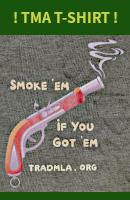Hi, welcome to the TMA Forum. You came to the right place, most of us here live muzzleloading.
I am relying strictly on memory here, and that is a process rapidly becoming less and less accurate.
Anyway, all moves are done on direct command and this is a process relying on paper cartridges, not loose components.
So, the first command is to retrieve a cartridge and bite the powder end off, then prime the pan with the loose powder exposed.
The second command is to ground your firelock and pour the powder from the cartridge down the bore.
The next command is to set the ball into the bore (with the paper trailing.
The next command is to remove the ram rod and push the paper/ball down the bore and seat it on the powder.
Then replace the ram rod in the stock and shoulder the musket.
Finally, the command to fire is given, and it starts all over again.
At some point the command to affix bayonettes is given and the melee begins.
I believe the standard was to be able to fire 5 shots a minute.
Interestingly, the infantryman was required to have four functional teeth in the front of his mouth. (To be able to bite off the end of the cartridge).
The one thing that glares out to me is the priming of the pan as the first step. Not quite a safety item there, but neither is standing in the direct path of an advancing company of men firing at you.
IN the "good old days" when I had a Bess, the touch hole was large enough in diameter that Ffg powder would adequately fill the pan in sufficient quantity as to not need a formal priming. Also not a good idea safety wise, but it did make candle shoots easier.
You are going to need a fair amount of practice to get your guys working together on this, but I think it will make a very impressive demonstration. I think a pretty good demonstration of this technique was shown in "The Patriot", IIRC.
Another thought, you might want to rip those plywood sheets in half lengthwise, as I doubt you would find very many British soldiers that were 4' wide.
Good luck,
John (Big Smoke)
If you really want to see what the commands were you should get a copy of the Manual of 1764 (The Manual Exercise as ordered by HIS MAJESTY in the year 1764). That is the drill manual the Brits used and many of the early militia. After the Winter of 1776/1777 then Von Steuben's manual was used. I do have a pdf copy of an original. If you'd like that, PM me with your e-mail address and I can send a pdf copy to you.
It's actually a bit weird because it starts presuming the "firelock is already charged. It proceeds with "Poise your firelock; Cock your firelock; Present (as opposed to the Continental's Take Aim command); and finally - "Fire". Then you come to the priming position, which has the but of the gun under your arm and the barrel at hat level. From here the orders are as follows:
• First command is "Cock your firelock" at which time you pull the cock back to 1/2 cocked position and push open the frizzen.
• Next is "Handle your cartridge". You slap your cartridge box, pull out a cartridge and hold it at your chin.
• Then comes the order "Prime". You tear the top of the cartridge off with your teeth and pour some powder out of the cartridge into the pan.
• After priming your pan, the next the order is "Shut your Pan" and you close the frizzen. After shutting your pan you move the firelock to the loading position on your left side in the proscribed manner with the muzzle the height of the chin.
**NOTICE** at this point you have black powder in the pan which can ignite if you screw up...so be aware of where the muzzle is during the rest of the exercise. Charging the pan before the barrel was done for speed. If you couldn't achieve a firing rate of 3 shots per minute, you were not allowed to be a British Soldier.
Modern hunters would charge the pan (prime the pan) AFTER loading the barrel for safety sake, and not before. But for historical accuracy, you should follow the commands. Not a big danger if you're firing blanks, but definitely have to be careful if you are live firing.
• Next order is "Charge with Cartridge". You pour the rest of the powder down the barrel and stuff the ball in the paper into the top of the muzzle. and then grab the top of the ramrod.
• Then comes "Draw your rammers", at which point you pull out the rammer, flip it over, and insert it into the top of the muzzle but don't push it down yet.
• Then you have "Ram down your cartridge" and you quickly ram it down then recover the rammer and insert it back in the pipes of your firelock. You now have a live charge in the pan and in the barrel.
• Next command is "shoulder your firelock" at which point you are ready to either move as commanded or fire as commanded. at the shoulder is considered the ready position and in practice later when this whole list of commands is just given as "Prime and Load" after going through all the following motions, you would return to the shoulder. When everyone was at "shoulder" the command to cock, present, and fire could be given. Idea was to make everyone fire all at once at exactly the same time.
• The commands at this point would revert to the beginning of Poise your Firelock; Cock your firelock; Present; and finally "Fire". after which the soldier automatically pulls the firelock down into the loading position.
As I mentioned earlier, this whole series of commands up to the "Poise your firelocks" is replaced on the battlefield with the command "Prime and Load" at which time each soldier goes perfectly through the many required steps that are shown above.
Bear in mind when you see a copy of an original Manual of 1764 that there are a lot of what look like "f" at the beginning of words. If you see that at the beginning of a word that "f" is actually and "s". Takes a little bit to get used to it but it's not too bad.
As much info as I just put out there, there is more in the manual as it describes very specific motions to use in each stage of each command. Some commands require 3 separate motions or more. So, don't guess at this. Get a manual and study it.
And to reiterate, the standard was 3-shots per minute, which with live ammo, is not a small task.
NOTE that the manual of Arms for the Continentals is similar but significantly different. And after the winter of '76/'77 the Colonials all used the Von Steuben manual of arms.
Hope that helps,
Twisted_1in66

Dan




